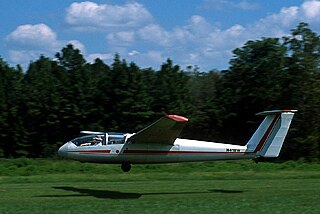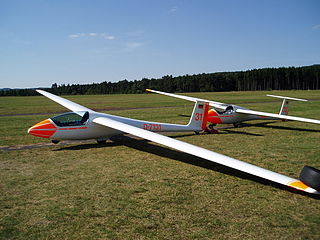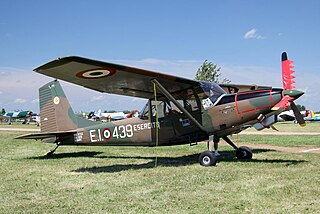| ATS-1 Ardhra | |
|---|---|
| Role | Training sailplane |
| Manufacturer | Civil Aviation Department of India, Hindustan Aeronautics |
| First flight | 5 March 1979 |
The Hindustan Ardhra (Meaning Green or The Moist One in Sanskrit) [1] was a sailplane designed in India for pilot training by the government's Civil Aviation Department in the late 1970s as the ATS-1 Ardhra. It was a two-seat aircraft of conventional configuration and wooden construction. The Indian Air Force ordered fifty examples in the early 1980s to be produced by Hindustan Aeronautics and the type was approved for use for flying by cadets.
Data from Jane's All the World's Aircraft 1988-89 [2]
General characteristics
Performance

The Schleicher ASW 15 is a single-seat sailplane designed in 1968 by Gerhard Waibel and manufactured by Alexander Schleicher GmbH & Co. The ASW 15 has shoulder-mounted wings and an all-flying tailplane, with its single tow-release placement a compromise between winching and aerotowing. The later ASW 15B had several improvements, including a tow-release placed on the plane of symmetry, an 11 cm taller rudder, a slightly larger main wheel, and the provision of a 90-litre water ballast system.

The ASW 19 is a single-seat glider built by Alexander Schleicher GmbH & Co, first flying in 1975. It was originally designed as a Standard Class glider, but now mainly competes in the Club Class. The ASW 19 is known for its pleasant handling and some clubs use it as a training glider. It was succeeded by the all-new Schleicher ASW 24.

The LET L-23 Super Blaník is a two-seat, all-metal structure glider with fabric covered control surfaces. The aircraft is primarily used for flight training; its single-seat sister model is the Let L-33 Solo.

The ICA IS-29 was a sailplane built in Romania in the 1970s. The prefix IS comes from Iosif Șilimon, the Romanian IAR aeronautical engineer who designed it.
The Civil Aviation Department Revathi was a light utility aircraft designed in India principally for use by that country's flying clubs.

The Caproni Vizzola C22 Ventura was a light jet-powered aircraft developed in Italy for use as a military trainer. It was of conventional sailplane configuration and bore a family resemblance to the Caproni Calif gliders, although the Ventura had an almost entirely metal structure. The student and instructor sat side by side under an expansive canopy, and weapons hardpoints were provided under each of the slender, high-mounted wings. It had retractable, tricycle undercarriage.
The Davis DA-5, a.k.a. DA-5A, is a single-seat sport aircraft designed in the United States in the 1970s and marketed for homebuilding. Like designer Leeon D. Davis's successful DA-2, it is a low-wing monoplane with fixed tricycle undercarriage and a V-tail, but with a much narrower fuselage accommodating only the pilot, and a lengthened nose. Design work was carried out in 1972, but the prototype was not built until 1974, when it was completed in only 67 days.

The Schleicher ASK 23 is a single-seat Club Class sailplane that was built by the German manufacturer Alexander Schleicher GmbH & Co.
The SIAI-Marchetti SM.101 was a 1940s Italian single-engined light transport cabin monoplane designed and built by SIAI-Marchetti.

The SIAI-Marchetti SM.1019 is an Italian STOL liaison monoplane built by SIAI-Marchetti for the Italian Army. It is a turboprop-powered derivative of the Cessna O-1 Bird Dog.

The ICA IS-28 is a two-seat sailplane produced in Romania in the 1970s. An all-metal aircraft of conventional design with a T-tail, it was originally produced with 15-metre wings, but in 1973, production shifted to the IS-28B with 17-metre wings and numerous aerodynamic refinements. These included a smaller tail with decreased dihedral, decreased dihedral on the wings, and redesigned fuselage contours. This version first flew on 26 April 1973 and was subsequently produced in versions with flaps (IS-28B2) and without (IS-28B1). Around 100 had been built by the early 1980s, with a substantial number sold for export. On April 7, 1979, Tom Knauff and R. Tawse set a world record with the IS-28 B2 glider, covering a distance of 829 kilometres on a predetermined out-and-return course from the Ridge Soaring Gliderport in Julian, Pennsylvania.
The ICA IS-32 is an open class high-performance metal two-seat sailplane produced in Romania in the 1970s. A refinement of the IS-28B, it shared most of that aircraft's fuselage, mated to new wings and empennage. This new wing had a span of 20 metres, featuring interconnected ailerons and flaps, Schempp-Hirth-type airbrakes. It had no provision for water ballast. The monowheel undercarriage differed from the IS-28 in being fully retractable.
The Partenavia P.55 Tornado was a 1950s Italian high-performance competition and touring monoplane built by Partenavia. The Tornado was a small mid-wing cantilever monoplane with a retractable tricycle landing gear. The aircraft was powered by a nose-mounted Lycoming O-320 piston engine.

The Valentin Taifun is a two-seat self-launching sailplane designed and built by Valentin Flugzeugbau GmbH of Hasfurt, Germany.

The Piel CP.80 Zephir , Piel CP.801 and Piel CP.802 are racing aircraft developed in France in the 1970s and marketed for homebuilding. They are compact, single-seat, single-engine monoplanes with low, cantilever wings.

The Scheibe SF 34 Delphin is a two-seat sailplane that was produced by Scheibe in Germany in the late 1970s and 1980s. Designed by Wolf Hoffmann and originally designated the SF H34, it was Scheibe's first unpowered aircraft of composite construction.
The Civil Aviation Department RG-1 Rohini is an Indian two-seat training sailplane of the 1960s. A high-winged wooden monoplane, with side-by-side seating;at least 107 were built.
The Chengdu X-7 Jian Fan is a Chinese basic trainer glider. First flying in 1966, at least 130 were built.

The Marske Monarch is a single-seat, high-wing, strut-braced, tailless ultralight glider and motor glider that was offered both as plans and a kit for amateur construction by Marske Aircraft.

The Politechnika Warszawska PW-2, also called the PW-2 Gapa, is a Polish lightweight high-wing, strut-braced single-seat, glider that was designed and built at the Warsaw University of Technology and also produced by DWLKK in the early 1990s. Total number of 19 gliders were built, including variant PW-2D bis.